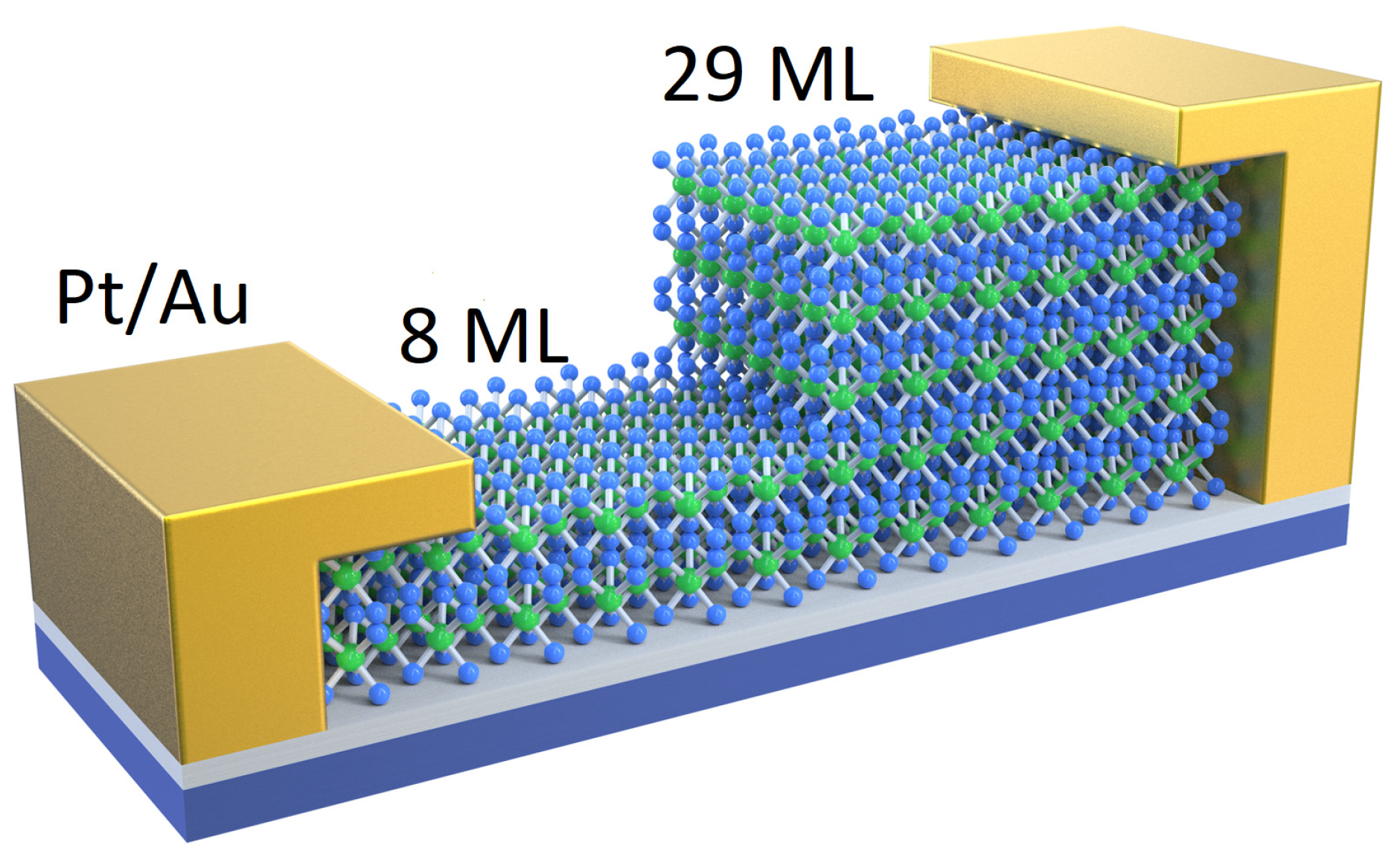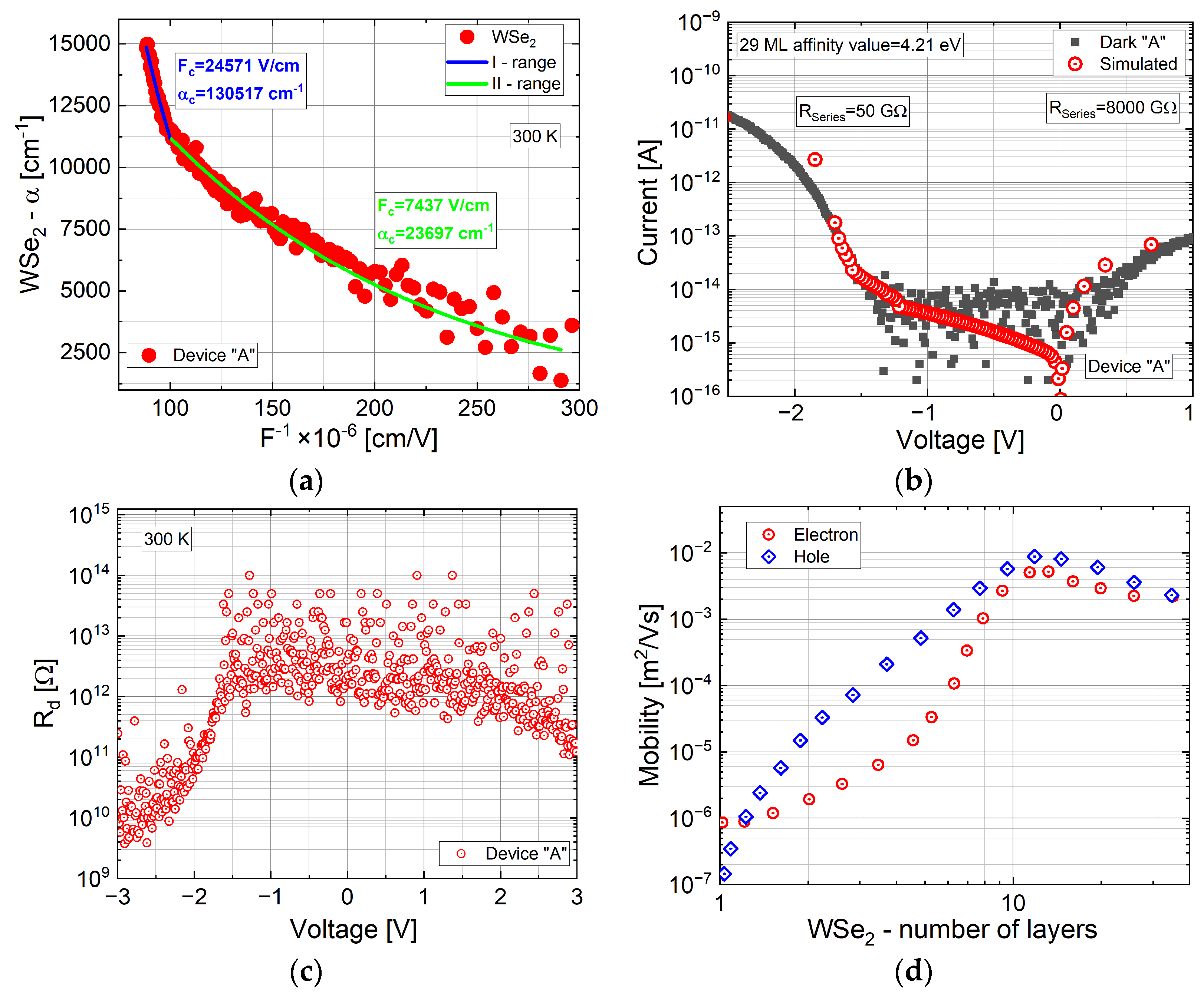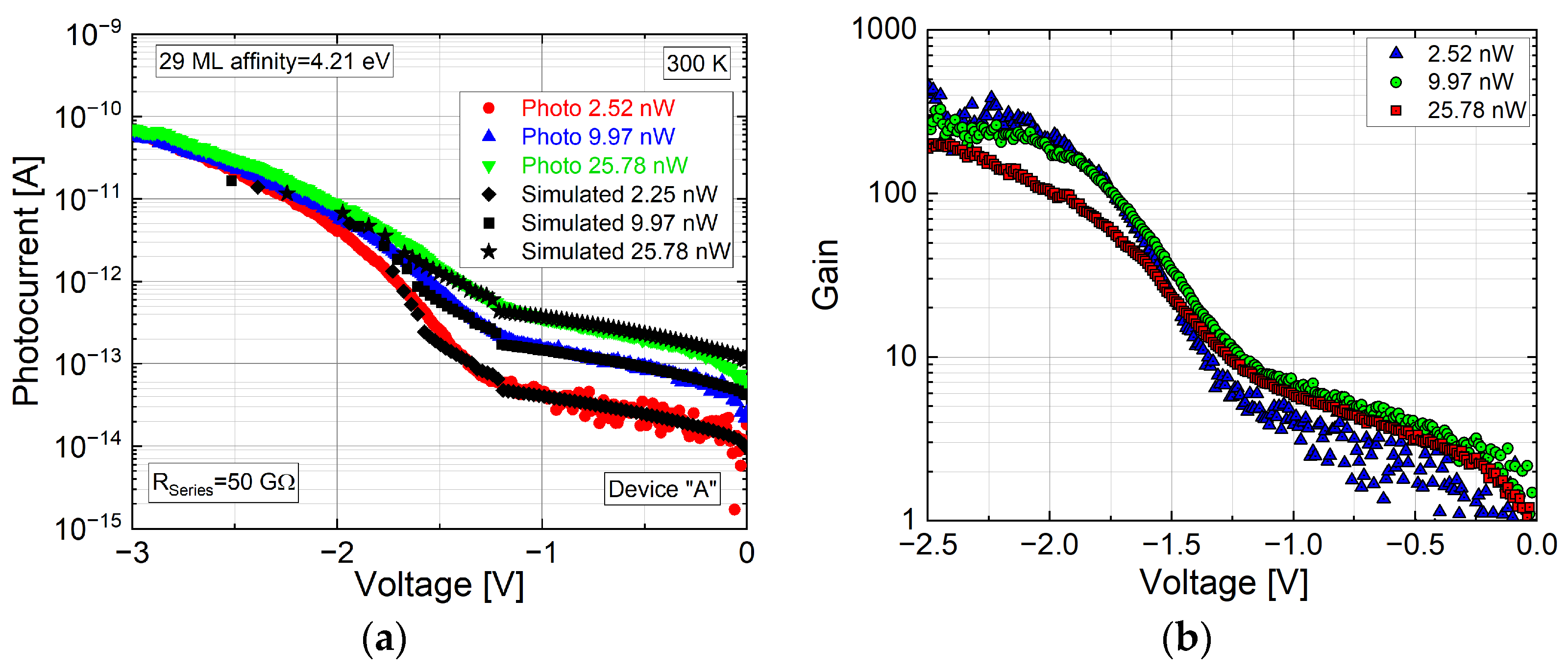Theoretical Analysis of Low-Threshold Avalanche Effect in WSe2 Stepwise van-der-Waals Homojunction Photodiodes †
Abstract
1. Introduction
2. Device Design
3. Simulation Results
4. Conclusions
Author Contributions
Funding
Institutional Review Board Statement
Informed Consent Statement
Data Availability Statement
Conflicts of Interest
References
- Paul, K.K.; Kim, J.-H.; Lee, Y.H. Hot carrier photovoltaics in van der Waals heterostructures. Nat. Rev. Phys. 2021, 3, 178–192. [Google Scholar] [CrossRef]
- Kim, J.H.; Bergren, M.R.; Park, J.C.; Adhikari, S.; Lorke, M.; Frauenheim, T.; Choe, D.-H.; Kim, B.; Choi, H.; Gregorkiewicz, T.; et al. Carrier multiplication in van der Waals layered transition metal dichalcogenides. Nat. Commun. 2019, 10, 5488. [Google Scholar] [CrossRef] [PubMed]
- Bude, J.; Hess, K. Thresholds of impact ionization in semiconductors. J. Appl. Phys. 1992, 72, 3554–3561. [Google Scholar] [CrossRef]
- Beard, M.C.; Luther, J.M.; Semonin, O.E.; Nozik, A.J. Third Generation Photovoltaics based on Multiple Exciton Generation in Quantum Confined Semiconductors. Acc. Chem. Res. 2013, 46, 1252–1260. [Google Scholar] [CrossRef] [PubMed]
- Hanna, M.C.; Beard, M.C.; Nozik, A.J. Effect of Solar Concentration on the Thermodynamic Power Conversion Efficiency of Quantum-Dot Solar Cells Exhibiting Multiple Exciton Generation. J. Phys. Chem. Lett. 2012, 3, 2857–2862. [Google Scholar] [CrossRef]
- Gao, A.; Lai, J.; Wang, Y.; Zhu, Z.; Zeng, J.; Yu, G.; Wang, N.; Chen, W.; Cao, T.; Hu, W.; et al. Observation of ballistic avalanche phenomena in nanoscale vertical InSe/BP heterostructures. Nat. Nanotechnol. 2019, 14, 217–222. [Google Scholar] [CrossRef] [PubMed]
- Kang, Y.; Liu, H.-D.; Morse, M.; Paniccia, M.J.; Zadka, M.; Litski, S.; Sarid, G.; Pauchard, A.; Kuo, Y.-H.; Chen, H.-W.; et al. Monolithic germanium/silicon avalanche photodiodes with 340 GHz gain–bandwidth product. Nat. Photonics 2009, 3, 59–63. [Google Scholar] [CrossRef]
- Wang, H.; Wang, F.; Xu, T.; Xia, H.; Xie, R.; Zhou, X.; Ge, X.; Liu, W.; Zhu, Y.; Sun, L.; et al. Slowing Hot-Electron Relaxation in Mix-Phase Nanowires for Hot-Carrier Photovoltaics. Nano Lett. 2021, 21, 7761–7768. [Google Scholar] [CrossRef] [PubMed]
- Kaushal, V.; Iñiguez-de-la-Torre, I.; Margala, M. Nonlinear electron properties of an InGaAs/InAlAs-based ballistic deflection transistor: Room temperature DC experiments and numerical simulations. Solid-State Electron. 2011, 56, 120–129. [Google Scholar] [CrossRef]
- Wen, J.; Wang, W.J.; Chen, X.R.; Li, N.; Chen, X.S.; Lu, W. Origin of large dark current increase in InGaAs/InP avalanche photodiode. J. Appl. Phys. 2017, 123, 161530. [Google Scholar] [CrossRef]
- Wang, H.; Xia, H.; Liu, Y.; Chen, Y.; Xie, R.; Wang, Z.; Wang, P.; Miao, J.; Wang, F.; Li, T.; et al. Room-temperature low-threshold avalanche effect in stepwise van-der-Waals homojunction photodiodes. Nat. Commun. 2024, 15, 3639. [Google Scholar] [CrossRef] [PubMed]



Disclaimer/Publisher’s Note: The statements, opinions and data contained in all publications are solely those of the individual author(s) and contributor(s) and not of MDPI and/or the editor(s). MDPI and/or the editor(s) disclaim responsibility for any injury to people or property resulting from any ideas, methods, instructions or products referred to in the content. |
© 2025 by the authors. Licensee MDPI, Basel, Switzerland. This article is an open access article distributed under the terms and conditions of the Creative Commons Attribution (CC BY) license (https://creativecommons.org/licenses/by/4.0/).
Share and Cite
Chojnowski, S.; Majkowycz, K.; Wang, H.; Hu, W.; Martyniuk, P. Theoretical Analysis of Low-Threshold Avalanche Effect in WSe2 Stepwise van-der-Waals Homojunction Photodiodes. Proceedings 2025, 129, 72. https://doi.org/10.3390/proceedings2025129072
Chojnowski S, Majkowycz K, Wang H, Hu W, Martyniuk P. Theoretical Analysis of Low-Threshold Avalanche Effect in WSe2 Stepwise van-der-Waals Homojunction Photodiodes. Proceedings. 2025; 129(1):72. https://doi.org/10.3390/proceedings2025129072
Chicago/Turabian StyleChojnowski, Sylwester, Kinga Majkowycz, Hailu Wang, Weida Hu, and Piotr Martyniuk. 2025. "Theoretical Analysis of Low-Threshold Avalanche Effect in WSe2 Stepwise van-der-Waals Homojunction Photodiodes" Proceedings 129, no. 1: 72. https://doi.org/10.3390/proceedings2025129072
APA StyleChojnowski, S., Majkowycz, K., Wang, H., Hu, W., & Martyniuk, P. (2025). Theoretical Analysis of Low-Threshold Avalanche Effect in WSe2 Stepwise van-der-Waals Homojunction Photodiodes. Proceedings, 129(1), 72. https://doi.org/10.3390/proceedings2025129072






